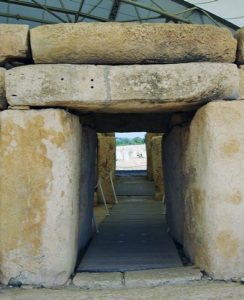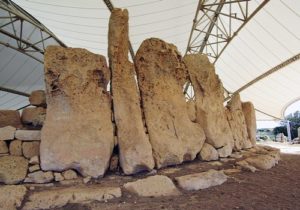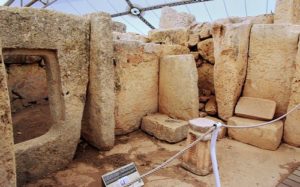Hagar Qim and Mnajdra Temples are on an isolated cliff side on the south coast of Malta. We caught a bus to Rabat and then picked up the bus which runs from Rabat south along the coast to the airport. This took us out through Dingli and then along the top of the cliffs. It is a good run with views of the cliffs. The road surface is very rough in places and it was a bouncy ride. The Chapel of St Mary Magdalene is a small rectangular building on the highest point of the cliffs built in the 17thC. Beyond is large quarry area to the left of the road and the surface becomes a lot better.
The bus does a detour through Siggiewi, a large and unexceptional settlement with a big square with a church and a few shops. Back on the coast road, we bounced along to Hagar Qim. There is no settlement and a few terraced fields. There are a few stone buildings in the fields, bird shooting shelters perhaps. Around Hagar Qim, there is little agriculture and the fields are disused.
It is a five minute walk up the road from the bus stop to the Heritage Malta building with a separately run restaurant behind. It is a big new building with ticket office, small shop, cafe, toilets. The ticket covers entry to both temple sites.
There is a five minute audiovisual which was high on visuals but the audio was just trendy music. It has a small and disappointing museum with trendy display boards which don’t say very much in Maltese and English. There are a few exhibits, mainly pottery and a replica of a fat lady. The best bit is the aerial models of Hagar Qim and Mnajdra temples.
It is a short walk to HAGAR QIM, set in a commanding position overlooking the sea. This is surrounded by a large security fence with a small kiosk where tickets are checked. A very elegant mushroom structure now protects most of the temple ruins from the sun and rain.
The temple dates from 3500BC and was in use until 2500BC. The main temple is unusual as the central apse is replaced by a second doorway to the outside. There are also smaller apses in the walls which open to the outside. It seems as if the temple plan was modified and extended at different times. There is a walkway round the outside of the main temple but very restricted access to the inside with a short fenced off walkway through the main temple.
The south east doorway is restored with a standing trilithon. To the left is a porthole doorway and a replica of the carved altar with pit marks and parallel lines as well as a stone with a spiral motif. The originals are in the Archaeology Museum in Valletta. The floor of the temple is covered with flagstones. In the second apse on the right, the stone wall is made up of massive blocks of stones with smaller stones lying on top. Each layer juts out slightly over the layer below suggesting this was a corbelled roof.
One stone has a hole through it and at the summer solstice, the rays of the sun shine through this onto the back wall. On the left is a short corridor with what are described as ‘mushroom’ altars. A flat stone is placed on an upright stone which has two holes carved in it. Four more apses lead off this. The one on the far left is accessed from inside temple, the others have external entrances.
Some of the megaliths making up the external walls are massive. Between the two right hand apses of the main temple is an external niche with a central pillar and two oracle holes.
There are the remains of two smaller temples outside the dome. One is in very poor condition. The other is better preserved and has five small apses. There is no access into either of them.
A paved walkway leads from Hagar Qim to the Mnajdra Temples. It is a 500m walk downhill across low, scrubby garrigue vegetation with fennel, spurge, thyme, wild carrot, wild onion. There are stone walls of disused fields and bird shooters hides. Two way marked paths are signed off the track. The longer one heads up the hillside. The shorter track heads down to Tal Hamrija watch tower. This makes a nice walk with views across to the small island of Filfa and north along the coast to Mnajdra Temples and the small new development on the coast beyond it.
There is another kiosk checking tickets at MNAJDRA TEMPLES. Security is taken very seriously and there is always someone patrolling the site keeping an eye on things after major vandalism.
Again the complex is covered by a mushroom, but you are unable to walk round the outside of the temples.
There are two large temples with the remains of a smaller one to the east with further bits of masonry scattered around. The temples stand along the curved side of a forecourt.
There is very restricted access to the temples. Steps lead up to the entrance of the East Temple, the smallest and the oldest temple. A lot of the walls have been reconstructed with limestone rubble. The uprights have a pitted decoration and are originals.
The Central Temple was the last to be built and is a simpler design. It sits on a raised dais as the ground levels are uneven. It has four apses with a large altar like structure at the far end. The doorway separating the far two apses has large chair like structures on either side. On the side of one of these is a carving of a small temple with a roof. In the second left side apse is a porthole slab leading to a small chamber built within the thickness of the walls.
The South Temple was built so that the doorway is aligned with the sunrise. At the spring and autumn equinoxes sunlight passes through the main doorway and hits the sides of two decorated slabs on either side of the entrance to the inner chamber. At the summer solstice the beam enters through the main door and hits the altar at the back of the temple.
There is a bench along the outside of the facade which extends beyond the temple walls along the edge of the forecourt. The entrance is a double trilithon structure. The front two apses are much larger than the back two and there is no access to these. The arrangement of the stones in the right apse suggest this had a corbelled roof. In the left apse is a porthole slab with pitted decoration leading to a small enclosed chamber.
These are two interesting temples in a beautiful site. Initially we had planned on not visiting these sites. Most pictures on the web are from before the new mushroom shaped covers had been erected. I had found a few pictures of these on google images and was concerned we might find them intrusive. In fact they weren't too bad and the even light made it easier for taking photographs.










